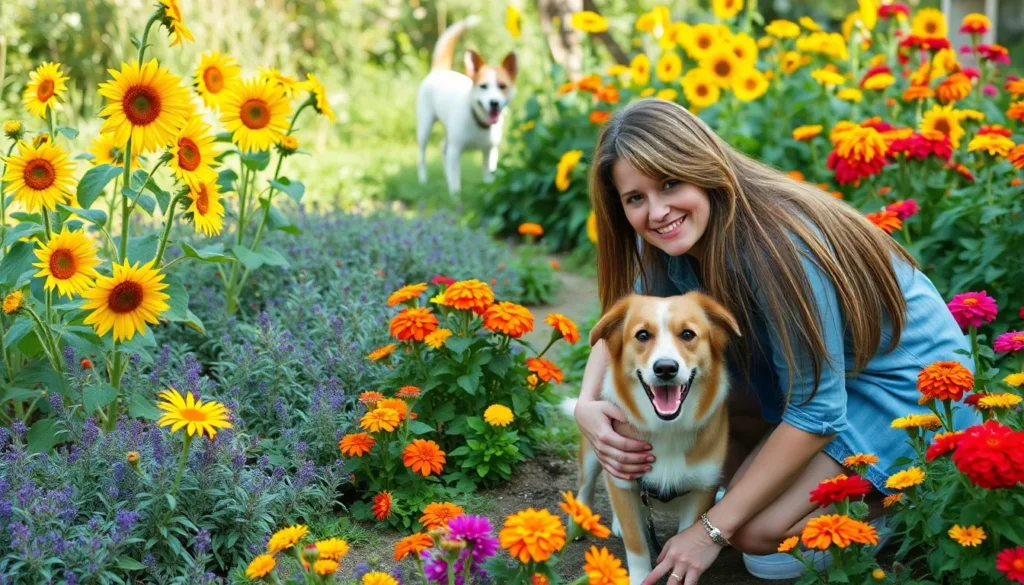We all want beautiful outdoor spaces where our furry friends can roam freely without worry. Creating a stunning garden that’s both gorgeous and safe for our beloved dogs doesn’t have to be a challenge – it just requires knowing which plants won’t harm our four-legged family members.
Many popular garden plants pose serious threats to dogs who love to explore with their mouths. From toxic blooms that cause stomach upset to leaves that trigger allergic reactions our pets face hidden dangers in spaces we design for relaxation and beauty.
The good news? Countless dog-friendly plants can transform your yard into a vibrant paradise that’s completely safe for curious canines. We’ll show you exactly which outdoor plants will make your garden flourish while keeping your pup protected and healthy.
Choose Native Ground Cover Plants That Are Safe for Dogs
Native ground cover plants offer the perfect solution for dog owners seeking durable landscaping options that won’t harm their pets. These hardy varieties thrive in local conditions while creating beautiful carpets of greenery that can withstand paws and playtime.
Creeping Thyme for Natural Lawn Alternatives
Creeping thyme transforms traditional grass areas into fragrant, low maintenance carpets that dogs love to explore. This Mediterranean herb releases a pleasant aroma when stepped on and produces tiny purple or white flowers throughout the growing season. We recommend varieties like Thymus serpyllum ‘Elfin’ or ‘Red Creeping Thyme’ for their exceptional durability and compact growth habit.
Benefits for dog owners include:
- Drought tolerance requiring minimal watering once established
- Natural pest deterrent properties that reduce the need for harmful chemicals
- Self seeding capability that fills in bare spots naturally
- Edible flowers and leaves that pose no threat if consumed by curious pets
Plant creeping thyme in full sun locations with well draining soil for best results. Space plants 6 to 12 inches apart to allow for spreading and expect full coverage within two growing seasons.
Wild Ginger for Shaded Areas
Wild ginger provides lush ground cover in areas where grass struggles to grow under trees and structures. This native perennial features heart shaped leaves that create dense mats while producing unique burgundy flowers close to the ground. Asarum canadense thrives in woodland conditions and requires virtually no maintenance once established.
Key characteristics that benefit dog friendly gardens:
- Shade tolerance in areas receiving less than 4 hours of direct sunlight
- Moisture retention that reduces watering needs during dry periods
- Dense growth pattern that prevents weeds naturally
- Non toxic properties safe for pets who may nibble on foliage
Wild ginger spreads slowly through underground rhizomes, making it ideal for contained areas where you want controlled coverage. Plant in rich, moist soil with good organic content for optimal growth.
Clover as a Durable Ground Cover Option
Clover creates resilient lawns that actually improve soil health while providing safe spaces for dogs to run and play. White clover (Trifolium repens) and microclover varieties offer excellent alternatives to traditional grass that require less water and fertilizer. These nitrogen fixing plants naturally enrich soil while maintaining their green appearance longer than conventional turf.
Advantages for pet owners include:
- Natural fertilization that eliminates the need for chemical lawn treatments
- Soft texture that’s gentle on paw pads during extended play sessions
- Quick recovery from wear patterns caused by regular dog traffic
- Edible properties that provide safe snacking for grazing pets
Establish clover by overseeding existing lawn areas or planting pure clover stands in designated dog runs. This versatile ground cover tolerates both sun and partial shade conditions while requiring minimal care throughout the growing season.
Select Dog-Safe Flowering Plants for Color and Beauty
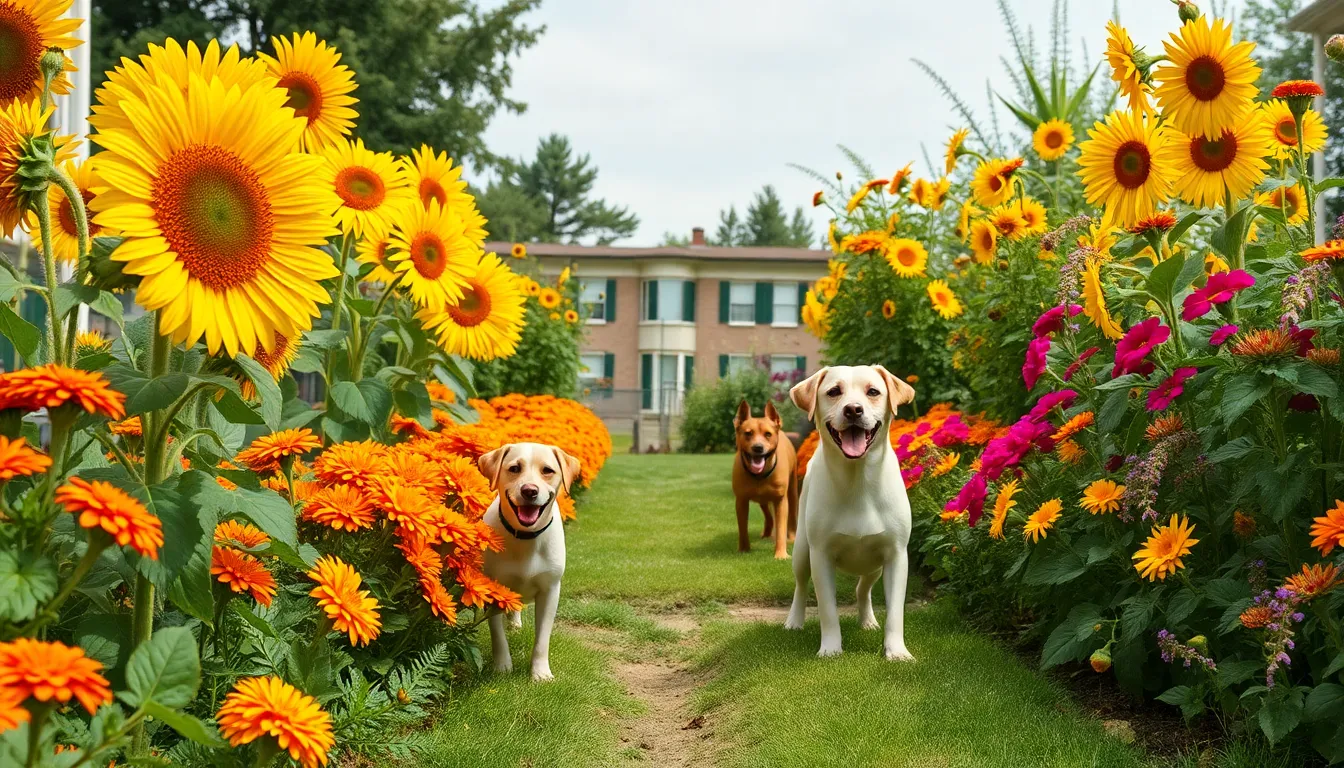
Moving beyond ground cover options, we can create stunning vertical displays with flowering plants that are completely safe for our four-legged family members.
Sunflowers for Tall, Cheerful Blooms
Sunflowers create dramatic focal points in our dog-friendly gardens with their towering stems and brilliant yellow blooms. These non-toxic giants thrive in full sun conditions and add instant vertical interest to any outdoor space. We can plant them along fence lines or in the back of garden beds where their sturdy stems won’t interfere with our dogs’ play areas. Their large flower heads attract beneficial pollinators while remaining completely safe if our curious pets decide to investigate or nibble.
Marigolds for Pest Control and Vibrant Colors
Marigolds serve double duty in our pet-safe gardens by providing bright orange and yellow blooms while naturally repelling unwanted insects. These hardy flowers are non-toxic to dogs and actually help protect our garden network by deterring mosquitoes, aphids, and harmful worms. We love how their strong scent discourages dogs from digging in flower beds, making garden maintenance easier. Marigolds bloom continuously throughout the growing season in full sun conditions, requiring minimal care while delivering maximum visual impact.
Snapdragons for Vertical Interest
Snapdragons offer enchanting tubular flowers in colors ranging from soft yellows to deep reds, creating beautiful vertical displays that are completely safe for our dogs. These whimsical blooms add height and texture to garden borders while tolerating occasional rough play from energetic pets. We can easily grow snapdragons from seed in sunny locations, and they’ll reward us with long-lasting flowers perfect for both garden display and indoor cut arrangements. Their sturdy nature means they can withstand normal pet activity while maintaining their colorful appeal throughout the season.
Plant Dog-Friendly Herbs That Serve Multiple Purposes
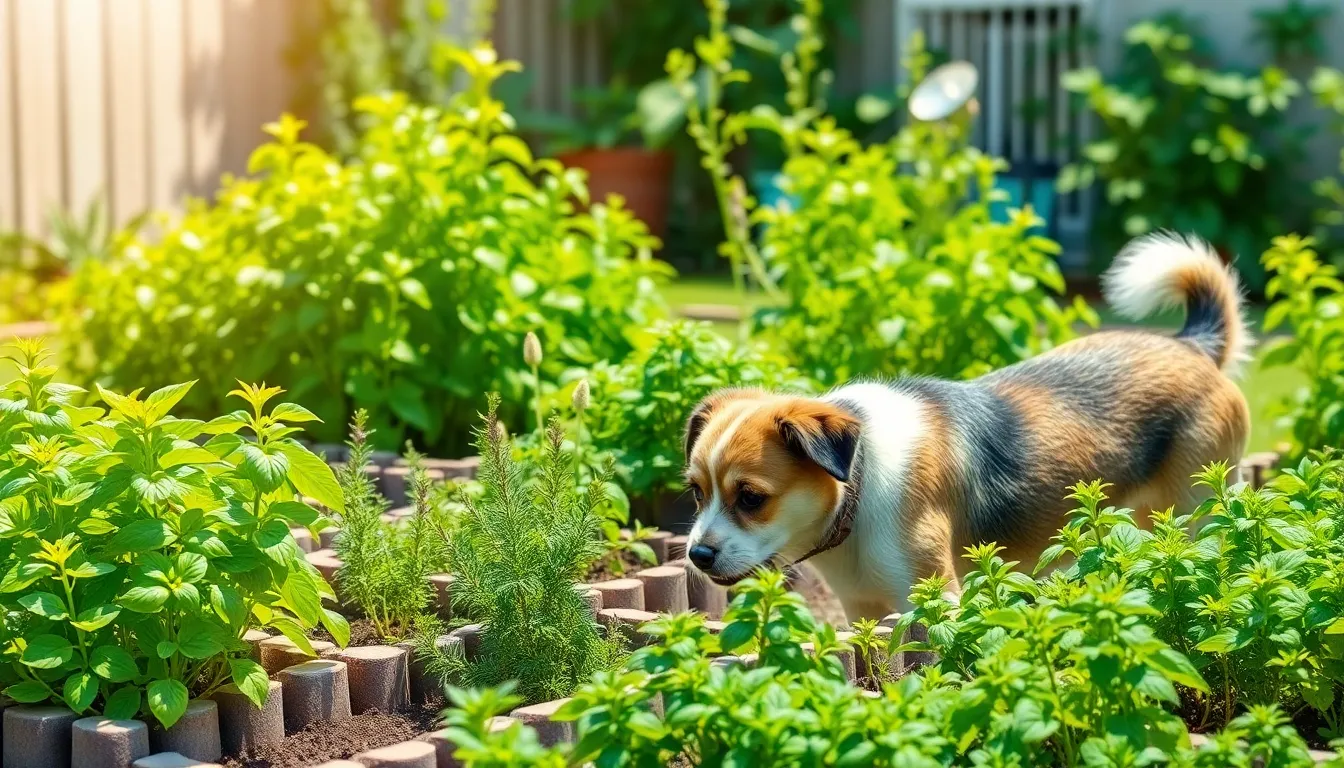
Beyond decorative plants, we can enhance our outdoor spaces with functional herbs that serve multiple purposes while keeping our dogs safe. These versatile additions provide culinary benefits, natural pest control, and aromatic landscaping elements.
Basil for Culinary Use and Pest Deterrent
Basil offers exceptional value as a dog-friendly herb that thrives in warm, sunny garden spots throughout the growing season. We can harvest fresh basil leaves for cooking while enjoying its natural pest-repelling properties that deter mosquitoes and flies from our outdoor spaces. This aromatic herb creates vibrant green foliage in garden beds or containers, adding visual appeal alongside its practical benefits. Dogs can safely explore around basil plants without risk of toxicity, making it an ideal choice for pet owners who want both function and safety in their gardens.
Rosemary for Aromatic Landscaping
Rosemary serves as an excellent landscaping element with its attractive evergreen foliage and distinctive fragrance that enhances any garden design. We can use this non-toxic herb as a fragrant shrub or garden accent that naturally repels insects while providing year-round structure to our outdoor spaces. Dogs can safely brush against or sniff rosemary plants without harm, allowing them to explore freely throughout the garden. This hardy herb requires minimal maintenance once established, making it a practical choice for busy pet owners who want beautiful, low-care landscaping options.
Parsley for Edible Garden Additions
Parsley provides bright green leaves that add nutritional value to both human and canine diets when used in moderate amounts. We can incorporate this versatile herb into edible garden designs where it serves as both a culinary ingredient and a safe plant for pets to investigate. This dog-friendly herb supports multi-purpose gardening by combining aesthetic appeal with practical harvesting opportunities. Fresh parsley grows easily in various garden conditions, allowing us to maintain a continuous supply of this nutritious herb while ensuring our outdoor spaces remain completely safe for our four-legged companions.
Incorporate Safe Shrubs and Bushes for Structure
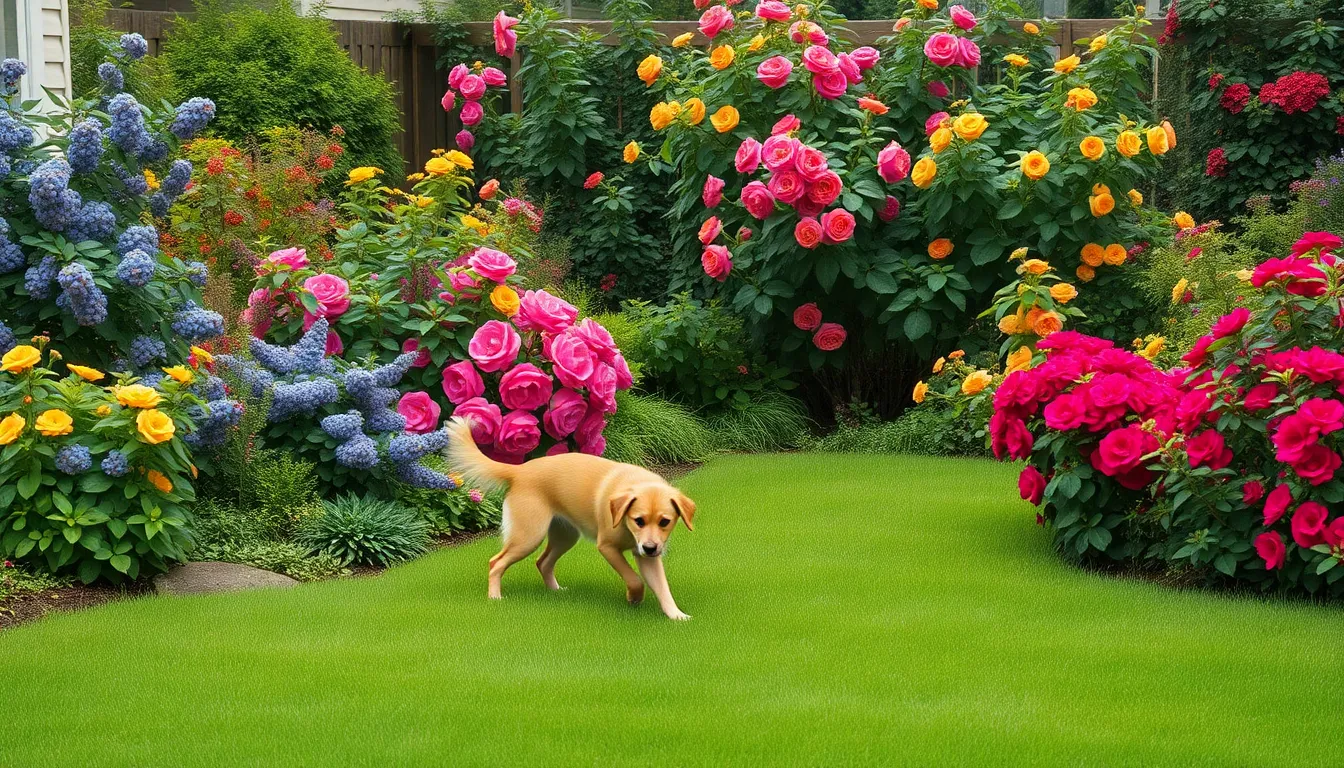
Structural plants like shrubs and bushes create the backbone of any well-designed garden while providing privacy and visual interest. Dog-friendly options such as camellia, osmanthus, and arborvitae offer robust hedging answers that can withstand pet activity while maintaining their beauty throughout the seasons.
Blueberry Bushes for Edible Landscaping
Blueberry bushes serve dual purposes in our dog-friendly gardens, combining ornamental beauty with edible rewards. These versatile shrubs thrive in acidic soil with plenty of sunlight, producing white blossoms in spring that transform into antioxidant-rich berries during summer months. Fall brings stunning colorful foliage that adds seasonal interest to the industry.
We love how blueberry bushes provide healthy treats that our dogs can safely enjoy in moderation. The berries are packed with antioxidants and nutrients that benefit both humans and pets. Container planting offers flexibility for those with limited space or challenging soil conditions, making these productive shrubs accessible to most gardeners.
Rose Bushes Without Thorns
Thornless shrub rose varieties eliminate the safety concerns associated with traditional roses while maintaining their classic beauty and fragrance. These specially bred cultivars provide stunning flowers without the risk of injury to curious dogs who love to explore garden beds. We recommend focusing on robust shrub rose types that can handle occasional pet traffic.
These roses contribute welcoming ambiance to any outdoor space through their colorful blooms and pleasant fragrance. Shrub varieties tend to be more disease resistant and require less maintenance than hybrid tea roses, making them practical choices for busy pet owners. Their sturdy growth habit also means they’ll bounce back quickly from any accidental damage caused by playful pups.
Butterfly Bush for Wildlife Attraction
Butterfly bush enhances biodiversity in our dog-friendly gardens while remaining generally non-toxic to pets. This flowering shrub attracts beneficial pollinators and wildlife, creating an captivating environment that provides natural entertainment for curious dogs. The plant’s ability to draw butterflies, bees, and birds adds ever-changing movement and interest to the garden throughout the growing season.
We appreciate how butterfly bushes offer seasonal interest through their long-blooming flowers and ability to support local ecosystems. Their drought tolerance once established makes them low-maintenance additions that continue performing year after year. Dogs often enjoy watching the activity these plants generate, from fluttering butterflies to busy bees collecting nectar.
Add Dog-Safe Trees for Shade and Privacy
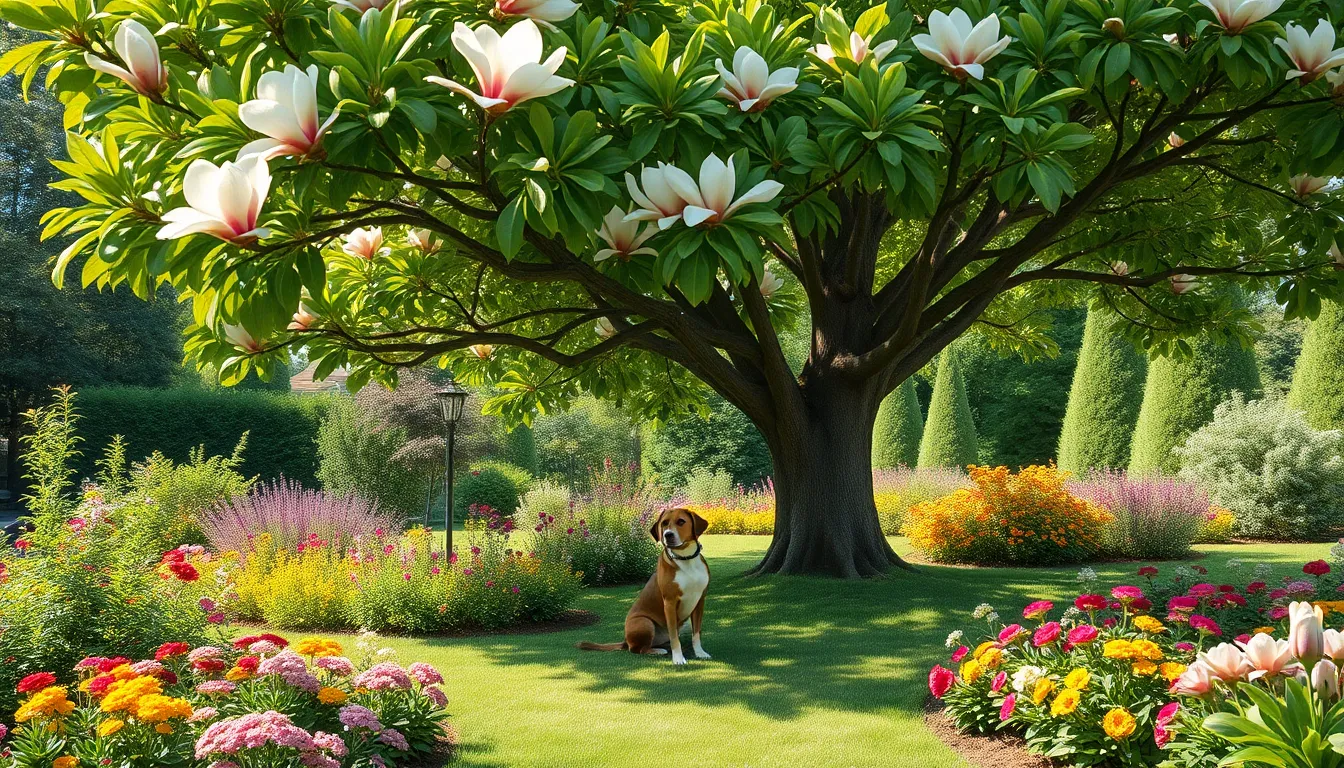
Creating vertical elements in our gardens provides essential shade and privacy while maintaining a safe environment for our beloved pets. These carefully selected trees offer the perfect combination of functionality and beauty for dog friendly outdoor spaces.
Fruit Trees Like Apple and Pear
Apple trees bring dual benefits to our dog friendly gardens by providing delicious fruit and safe shade coverage. The fruit itself poses no toxicity risks to our pets though we should remove seeds before sharing treats with our dogs since they contain trace amounts of cyanogenic compounds.
Pear trees offer similar advantages with their beautiful spring blossoms and sweet summer fruit that’s completely safe for our canine companions. These trees require minimal maintenance while delivering maximum value through their edible harvests and protective canopy coverage. Both varieties thrive in most climates and create natural gathering spots where we can relax with our pets.
Dogwood Trees for Seasonal Interest
Dogwood trees deliver year round visual appeal through their stunning seasonal transformations that keep our gardens interesting throughout all seasons. Spring brings magnificent flower displays in white or pink hues while fall showcases brilliant red and orange foliage that creates a spectacular backdrop for outdoor activities with our dogs.
These native trees adapt well to various soil conditions and provide excellent shade coverage without growing too large for most residential properties. Their non-toxic nature means we can plant them confidently knowing our curious pets won’t face any health risks from nibbling on fallen leaves or bark.
Magnolia Trees for Fragrant Blooms
Magnolia trees create luxurious focal points in our dog friendly landscapes with their large fragrant flowers that bloom before the leaves emerge each spring. These impressive trees offer substantial shade coverage once established while maintaining their pet safe status throughout their long lifespan.
Southern magnolias provide evergreen coverage in warmer climates while deciduous varieties like star magnolia work well in cooler regions where we need seasonal shade patterns. Their thick glossy leaves create dense canopies that offer cool retreats during hot summer days when our dogs need shelter from intense sun exposure.
Create Designated Dog Areas with Safe Plant Borders
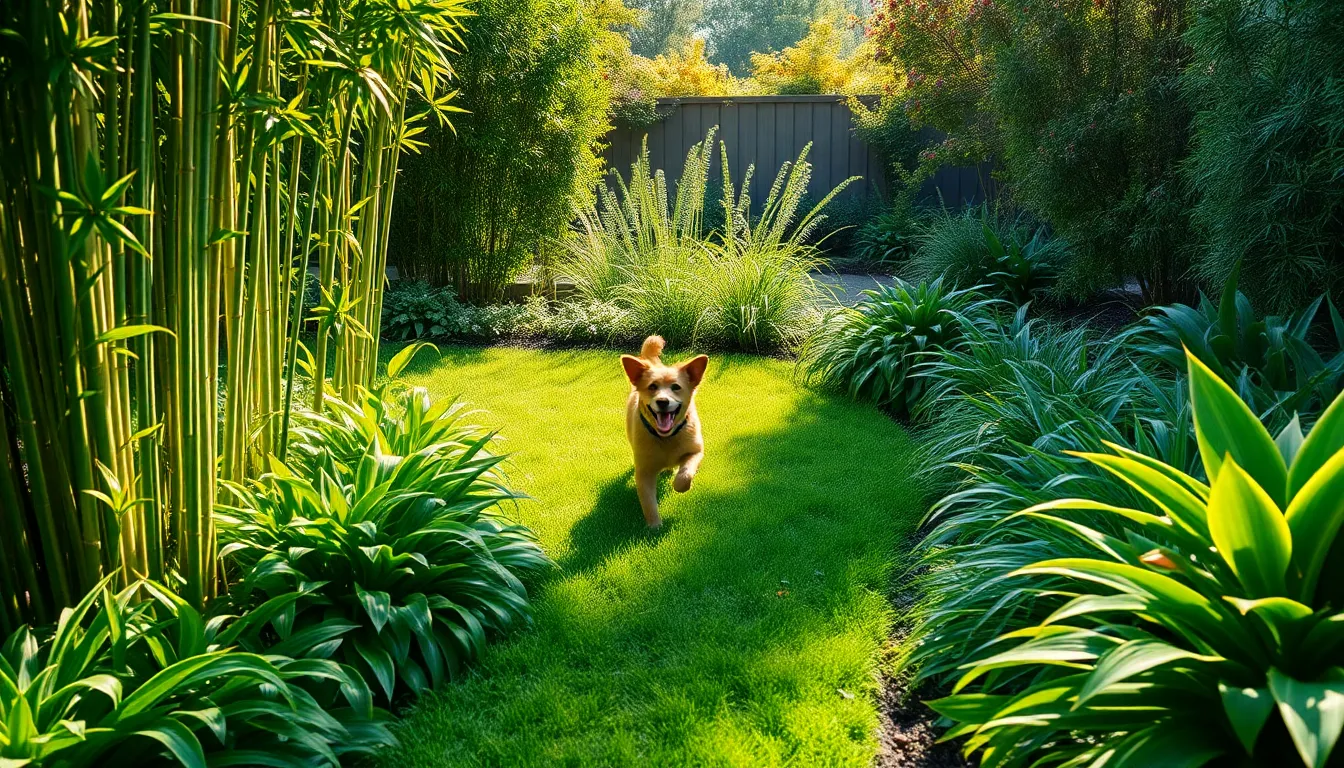
Establishing exact zones in your yard helps protect both your garden and your furry companion from potential conflicts. Strategic placement of non-toxic plants creates natural boundaries that guide your dog’s movement while maintaining the visual appeal of your outdoor space.
Bamboo for Natural Fencing
Bamboo stands out as our top choice for creating sturdy, pet-safe boundaries in dog-friendly gardens. This fast-growing plant forms dense privacy screens that naturally contain your pet’s activities while adding vertical interest to your industry design. We’ve found that bamboo’s non-toxic properties make it safe for curious dogs who might nibble on foliage, and its resilient structure withstands rough play without breaking or causing injury.
Growing bamboo requires minimal maintenance once established, making it a practical long-term solution for busy pet owners. The plant’s ability to reach substantial heights quickly means you’ll have an effective natural fence within just one growing season. Choose clumping varieties over running types to maintain better control over growth patterns and prevent unwanted spreading throughout your garden.
Ornamental Grasses for Texture
Ornamental grasses bring movement and softness to designated dog areas without compromising safety or durability. These hardy plants tolerate drought conditions exceptionally well, reducing your watering needs while maintaining their attractive appearance throughout various weather conditions. We recommend using ornamental grasses as gentle visual barriers around play zones, where their flexible blades can bend without breaking when your dog runs through them.
Fountain grass and feather reed grass work particularly well in sunny locations, while sedges thrive in shadier spots where other plants might struggle. Their varied heights and textures create natural layering that adds depth to your garden design. Most ornamental grasses are completely safe for dogs and actually benefit from occasional trampling, which helps prevent them from becoming too dense or overwhelming smaller plants nearby.
Hosta Plants for Shade Gardens
Hostas excel in shaded areas where many other plants fail to thrive, making them perfect for creating lush, dog-safe garden spaces under trees or alongside buildings. These perennials produce broad, textured leaves that add substantial visual weight to shadowy corners while remaining completely non-toxic to curious pets. We pair hostas with coral bells to create multi-season interest, as coral bells provide colorful foliage that persists when hostas go dormant in winter.
Both plants require minimal care once established and actually prefer the consistent moisture levels found in areas where dogs frequently play and drink water. Their low-growing habit makes them ideal for bordering pathways or creating soft transitions between different garden zones. Hostas come in dozens of varieties with different leaf colors and patterns, allowing you to create sophisticated shade gardens that remain beautiful and safe for your four-legged family members.
Design Safe Vegetable Gardens Dogs Can Explore
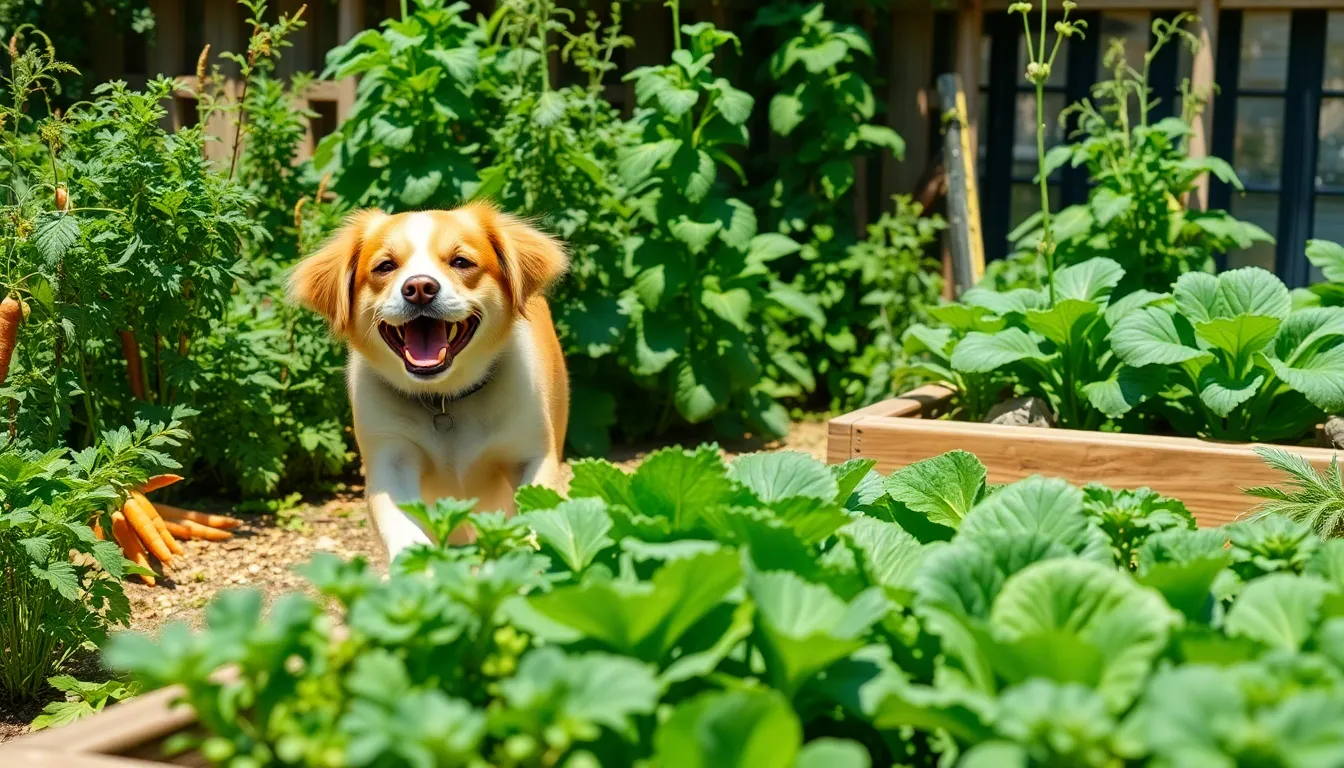
Creating an edible garden that welcomes both our families and our dogs opens up wonderful possibilities for fresh produce while maintaining pet safety. We can thoughtfully select vegetables that thrive outdoors and pose no threat to curious canines who love to explore and occasionally sample garden treats.
Carrots and Sweet Potatoes for Root Vegetables
Carrots serve as excellent starter plants for dog friendly vegetable gardens since they’re completely safe for our pets to nibble and provide crunchy, healthy treats. These hardy root vegetables grow well in most outdoor conditions and actually benefit dogs with vitamins and fiber when consumed in moderation. Sweet potatoes offer another fantastic root vegetable option that dogs can safely enjoy, though we should monitor portions to prevent digestive upset from overindulgence.
Underground vegetables like these create natural foraging opportunities for dogs while producing nutritious harvests for our kitchen tables. Growing these crops in raised beds or designated garden sections helps us maintain better control over our dogs’ access while encouraging healthy exploration behaviors.
Green Beans and Peas for Climbing Plants
Green beans transform ordinary garden spaces into vertical growing areas that dogs find fascinating to investigate, requiring 6 to 8 hours of sunlight and consistent moisture for optimal growth. These climbing vegetables produce twisty green vines on trellises that create natural privacy screens while offering safe, edible treats that many dogs absolutely love. Trellised bean plants maximize our garden space while providing captivating vertical elements that satisfy our dogs’ curiosity without safety concerns.
Peas complement green beans perfectly as another climbing plant that grows on support structures and produces fresh, dog safe pods throughout the growing season. These climbing legumes thrive in cooler weather and provide early season harvests that both we and our pets can enjoy together.
Lettuce and Spinach for Leafy Greens
Lettuce varieties provide safe leafy options that dogs can sample without harm, though we recommend monitoring consumption to prevent stomach upset from large quantities. These cool season crops grow quickly in outdoor gardens and offer fresh salad greens for our meals while creating lush, green spaces that dogs enjoy exploring.
Spinach requires more careful consideration since it contains oxalates that can cause health issues if dogs consume large amounts regularly. We can safely include spinach in our dog friendly gardens by planting it in areas where we can easily supervise our pets’ access and offer only small tastes occasionally. Growing spinach alongside other leafy greens creates diverse garden textures while maintaining overall safety for our canine companions.
Establish Safe Water Garden Plants for Pond Areas
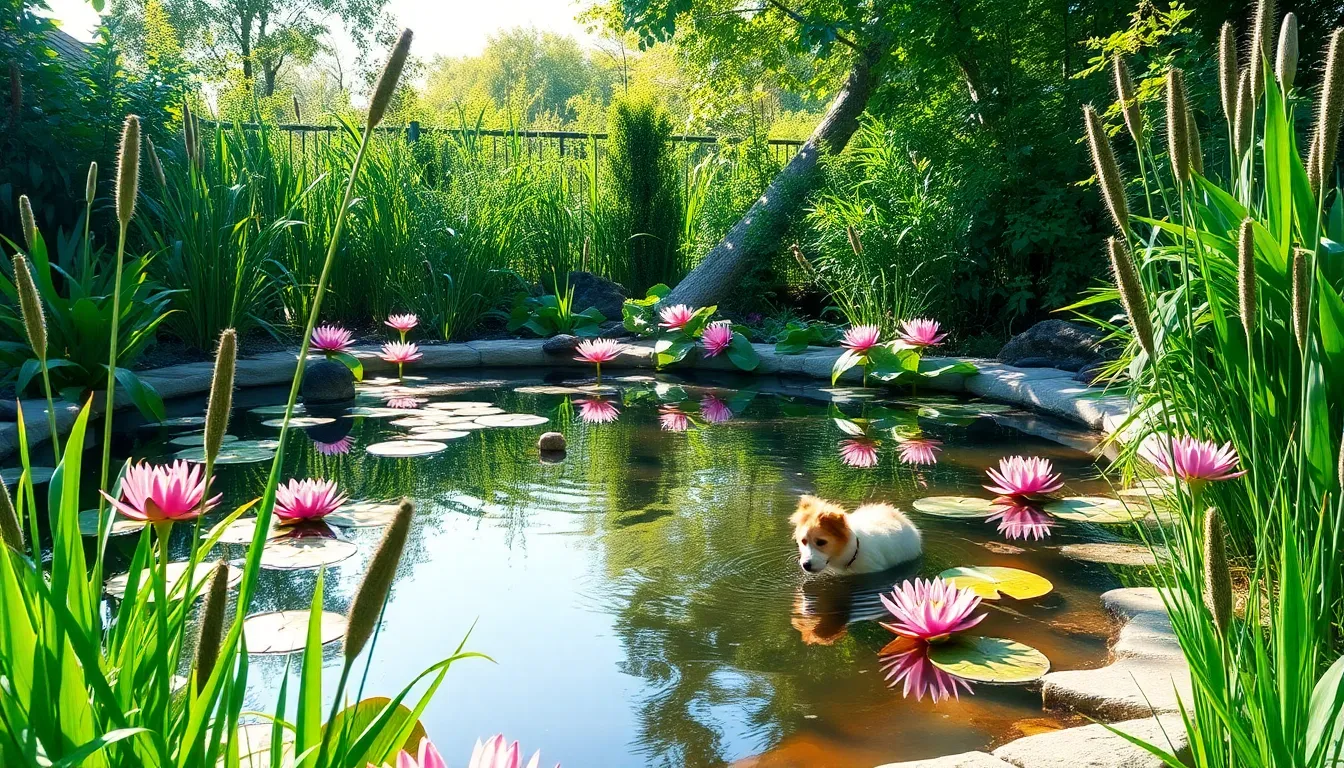
Water features add tranquil beauty to our dog-friendly gardens while providing cooling spaces for our pets. Creating pond areas with safe aquatic plants ensures our furry companions can explore waterside environments without toxic plant exposure.
Water Lilies for Floating Beauty
Water lilies create stunning floating displays that transform ordinary ponds into picturesque garden focal points. These attractive aquatic plants provide essential shade to pond water, naturally controlling algae growth while maintaining water quality for both pets and wildlife. We find that most water lily species are generally safe around dogs since pets typically avoid eating these floating plants. Their broad leaves and vibrant blooms create protective habitats for beneficial pond wildlife, including frogs and beneficial insects that help maintain network balance. Floating coverage from water lilies prevents excessive sunlight penetration, reducing water temperature and creating comfortable conditions for dogs who enjoy pond edge exploration.
Cattails for Natural Pond Edges
Cattails establish robust natural boundaries along pond margins that withstand playful pet activity while providing excellent erosion control. These emergent plants are completely non-toxic to dogs, making them ideal choices for households with curious pets who love waterside adventures. We recommend cattails because they offer shelter and natural filtration, improving water quality through their root systems that absorb excess nutrients. Their distinctive brown seed heads create visual interest throughout seasons while providing nesting materials for beneficial wildlife. Dogs can safely explore around cattail clusters without poisoning risks, and these plants help stabilize pond edges against erosion from pet foot traffic.
Water Hyacinth for Oxygenation
Water hyacinth serves as an efficient oxygenating plant that maintains healthy pond water quality essential for aquatic network balance. This floating plant is generally considered dog-friendly, though we recommend monitoring exact species selections to ensure maximum safety for our pets. Water hyacinth assists in oxygenating pond water by absorbing carbon dioxide and releasing oxygen during photosynthesis, supporting fish populations and preventing stagnant water conditions. We appreciate how these plants help prevent algae blooms that can create unsightly pond surfaces and potentially harmful conditions for dogs who drink from water features. Their purple flower spikes add vertical color interest while their root systems naturally filter pond water, creating cleaner environments for pet interaction.
Conclusion
Creating a dog-friendly outdoor space doesn’t mean compromising on beauty or functionality. With thoughtful plant selection we can design gardens that protect our furry friends while delivering stunning visual appeal year-round.
The key lies in choosing plants that serve multiple purposes – from fragrant herbs that repel pests to colorful flowers that attract pollinators. Whether we’re establishing ground cover alternatives to traditional grass or incorporating edible vegetables our dogs can safely explore we’re building spaces that work for everyone.
Remember that a pet-safe garden is an investment in our dogs’ health and our peace of mind. By selecting non-toxic plants that withstand playful paws and curious noses we’re creating outdoor environments where our pets can roam freely and safely.
Start small with a few recommended plants and gradually expand your dog-friendly garden. Your four-legged family members will thank you for the safe space to explore and play.
Frequently Asked Questions
What are the most dangerous garden plants for dogs?
Common toxic garden plants include azaleas, oleander, foxglove, lily of the valley, and sago palms. These plants can cause serious health issues ranging from stomach upset and vomiting to more severe complications like organ damage. Always research plants before adding them to your garden and remove any toxic species if you have pets.
Which ground cover plants are safest for dogs to walk on?
Creeping thyme, wild ginger, and clover are excellent dog-safe ground cover options. Creeping thyme is drought-tolerant and acts as a natural pest deterrent. Wild ginger thrives in shade with minimal maintenance. Clover improves soil health while providing a soft, resilient surface that withstands pet activity.
Can I grow flowers in my garden if I have dogs?
Yes! Many beautiful flowers are completely safe for dogs. Sunflowers add height and attract pollinators, marigolds repel pests with their vibrant colors, and snapdragons provide vertical interest. These flowering plants can withstand playful dogs while maintaining colorful displays throughout the growing season.
What herbs are safe to grow around dogs?
Basil, rosemary, and parsley are dog-friendly herbs that serve multiple purposes. Basil repels pests naturally and thrives in sunny locations. Rosemary provides aromatic evergreen foliage while deterring insects. Parsley is nutritious and safe for dogs in moderation, making it perfect for edible gardens.
Are there dog-safe shrubs that can provide garden structure?
Camellia, osmanthus, and arborvitae shrubs are excellent structural plants that are safe for dogs. Blueberry bushes offer dual benefits with ornamental beauty and edible treats. Thornless rose varieties provide classic appeal without injury risks, while butterfly bushes attract wildlife and enhance garden biodiversity.
Which trees are safest for dogs and provide good shade?
Apple and pear trees offer safe shade plus edible fruit (avoid sharing seeds). Dogwood trees provide seasonal interest with non-toxic foliage. Magnolia trees deliver fragrant blooms and substantial shade coverage. All these options create comfortable, safe outdoor spaces for dogs to enjoy.
Can dogs safely explore vegetable gardens?
Yes, when planted with dog-friendly vegetables. Carrots and sweet potatoes are safe for dogs to nibble. Green beans and peas work well as climbing plants that maximize space. Leafy greens like lettuce are generally safe, though spinach should be limited due to oxalate content.
Are water garden plants safe for dogs around ponds?
Many aquatic plants are dog-friendly. Water lilies provide beautiful floating displays while controlling algae. Cattails create natural boundaries without toxicity concerns. Water hyacinth helps oxygenate pond water and prevents harmful algae blooms. These plants enhance waterside safety for exploring dogs.
How can I create boundaries in my dog-friendly garden?
Use non-toxic plants like bamboo for sturdy, pet-safe fencing. Ornamental grasses add texture and movement to designated play areas. Hostas work well in shaded boundary areas, providing lush foliage that’s safe for curious pets while maintaining visual appeal and garden organization.
What should I consider when planning a dog-safe garden?
Focus on selecting non-toxic plants that can withstand pet activity. Consider your dog’s behavior – diggers may need different plant choices than gentle explorers. Plan designated play areas, ensure adequate shade, and research every plant before installation. Always consult your veterinarian about specific plants if concerned.

